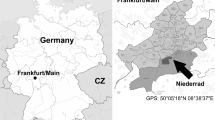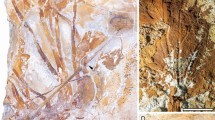Abstract
A systematic reassessment of megafossil records ofFagaceae in Central Europe has been undertaken on the basis of leaf cuticular characters. The oldest representatives date back to the Eocene:Quercus subhercynica spec. nova,Dryophyllum furcinerve (Rossm.)Schmalh.,Trigonobalanopsis rhamnoides (Rossm.) gen. & comb. nov. In the Oligocene other members of extant genera appear:Quercus rhenana (Weyl. & Kilpp.)Knobloch & Kvaček,Fagus attenuata Goepp.,Lithocarpus saxonicus spec. nova. In the Neogene these ancient taxa (except inFagus lineage), are gradually replaced by deciduous species ofQuercus andCastanea. Trigonobalanus andCastanopsis are recorded by fruits (or wood) only.
Similar content being viewed by others
References
Andreánszky, G., Kovács, É., 1964: Der Verwandtschaftskreis der Eiche in der Unteroligozänen Flora von Kiseged bei Eger (Oberungarn). — Egri Muz. Évk.2: 7–42.
Andrews, H. N., 1970: Index of generic names of fossil plants, 1820–1965. — U.S. Geol. Surv. Bull.1300: 1–354.
Baas, P., 1982: Comparative leaf anatomy ofTrigonobalanus Forman Fagaceae. — Blumea28: 171–175.
Burgh, J. v. d., 1973: Hölzer der niederrheinischen Braunkohlenformation, 2. — Rev. Palaeobot. Palyn.15: 73–275.
—, 1978: The Pliocene flora of Fortuna-Garsdorf 1. — Rev. Palaeobot. Palyn.26: 173–211.
Camus, A., 1934–1954: Les Chênes. Monographie du genreQuercus (etLithocarpus). — Paris: Lechevalier.
Ettingshausen, C. v., 1870: Beiträge zur Kenntnis der Tertiärflora Steiermarks. — Sitz.-Ber. Akad. Wiss. Math.-Nat. Kl.60: 17–100.
—, 1880: Beiträge zur Erforschung der Phylogenie der Pflanzenarten 3–7. — Denkschr. K. Akad. Wiss. Math.-Nat. Kl.43: 93–102.
Forman, L. L., 1964:Trigonobalanus, a new genus ofFagaceae, with notes on the classification of the family. — Kew Bull.17: 381–396.
Hardin, J. W., 1976: Terminology and classification ofQuercus trichomes. — J. Elisha Mitchell Sci. Soc.92: 151–161.
—, 1979: Patterns of variation in foliar trichomes of eastern North AmericanQuercus. — Amer. J. Bot.66: 576–585.
Hummel, A., 1983: The Pliocene leaf flora from Ruszów near Zary in Lower Silesia, SW Poland. — Prace Muz. Ziemi36: 9–104.
Iljinskaja, I. A., 1980: K sistematike iskopaemychFagaceae SSSR (ustanovlennych po ostatkam list'ev i cvetkov i otpečatkam plodov). — InŽilin, S. G., (Ed.): Sistematika i evoljucija vysšich rastenij, pp. 20–29. — Leningrad: Nauka.
Jain, D. K., Singh, V., 1974: Epidermal studies in some Himalayan species of oaks and their taxonomic significance. — Proc. Ind. Acad. Sci.1380: 188–196.
Jones, J. H., 1986: Evolution of theFagaceae: the implications of foliar features. — Ann. Missouri Bot. Gard.73: 228–275.
-Manchester, S. R., Dilcher, D. L., in press:Dryophyllum Debey exSaporta, juglandaceous not fagaceous. — Rev. Palaeobot. Palyn.
Kirchheimer, F., 1937: Beiträge zur Kenntnis der Flora des baltischen Bernsteins 1. — Beih. Bot. Centralbl. B,57: 441–484.
Knobloch, E., 1986: Die Flora aus der Oberen Süßwassermolasse von Achldorf bei Vilsbiburg (Niederbayern). — Docum. Nat.30: 14–48.
—, 1976: Miozäne Blätterfloren vom Westrand der Böhmischen Masse. — Rozpr. Ústř. úst. geol.42: 1–131.
—, 1986: Die obermiozäne Flora von Likudi bei Elassona/Thessalien, Griechenland. — Docum. Nat.29: 5–20.
Kräusel, R., Weyland, H., 1950: Kritische Untersuchungen zur Kutikularanalyse tertiärer Blätter 1. — Palaeontographica B91: 7–92.
—, 1954: Kritische Untersuchungen zur Kutikularanalyse tertiärer Blätter 2. — Palaeontographica B96: 106–163.
Kvaček, Z., Walther, H., 1987: Revision der mitteleuropäischen tertiären Fagaceen nach blattepidermalen Charakteristiken. 1. Teil —Lithocarpus Blume. — Feddes Repert.98: 637–652.
Mai, D. H., 1964: Die Mastixioideen-Floren im Tertiär der Oberlausitz. — Paläont. Abh. B,2: 1, 1–192.
—, 1970: Die tertiären Arten vonTrigonobalanus Forman (Fagaceae) in Europa. — Jahrb. Geol.3 (1967): 281–409.
—, 1978: Die Floren der Haselbacher Serie im Weisselster-Becken (Bezirk Leipzig, DDR). — Abh. Staatl. Mus. Min. Geol. Dresden28: 1–200.
—, 1985: Die obereozänen Floren des Weisselster-Beckens und seiner Randgebiete. — Abh. Staatl. Mus. Min. Geol. Dresden33: 1–260.
Manchester, S. R., Crane, P. R., 1983: Attached leaves, inflorescences, and fruits ofFagopsis, an extinct genus of fagaceous affinity from the Oligocene Florissant flora of Colorado, U.S.A. — Amer. J. Bot.70: 1147–1164.
Melville, R., 1982: The biogeography ofNothofagus andTrigonobalanus and the origin of theFagaceae. — Bot. J. Linn. Soc.85: 75–88.
Olsson, V., 1975: The structure of stellate trichomes and their taxonomic implication in someQuercus species (Fagaceae). — Bot. Not.128: 412–424.
Rossmässler, E. A., 1840: Die Versteinerungen des Braunkohlensandsteines aus der Gegend von Altsattel in Böhmen (Elnbogener Kreises). — Dresden, Leipzig: Arnoldische Buchhandlung.
Rüffle, L., 1963: Die obermiozäne (sarmatische) Flora vom Randecker Maar. — Paläont. Abh. B,1: 139–295.
—, 1979: Verwandtschaftskreis und die Zönogenese vonQuercus apocynophyllum Ett. in der Tertiärflora Mittel- und Südosteuropa. — Phytology, Bulg. Acad. Sci.13: 31–58.
—, 1976: WeitereRanales, Fagaceae, Loranthaceae, Apocynaceae. — In Eozäne Floren des Geiseltales, Abh. Zentr. Geol. Inst.26: 199–282.
Schwarz, O., 1936: Entwurf zu einem natürlichen System der Cupuliferen und der GattungQuercus L. — Notizbl. Bot. Gart. Berlin-Dahlem8: 1–22.
Selmeier, A., 1970a: EinCastanopsis-Holz aus jungtertiären Schichten Südbayerns (Schrobenhausen). — N. Jahrb. Geol. Paläont. Mh.1970: 235–250.
—, 1970b:Castanopsis-Hölzer aus obermiozänen Glimmersanden der südlichen Franckenalb. — Mitt. Bayer. Staatssamml. Paläont. Hist. Geol.10: 309–320.
—, 1972: EinCastanopsis-Holz aus oberchattischen Steigbach-Schichten des Allgaus. — Mitt. Bayer. Staatssamml. Paläont. Hist. Geol.12: 97–104.
Soepadmo, E., 1968: A revision ofQuercus L. subgen.Cyclobalanopsis (Oersted.)Schneider in Malesia. — Gardens Bull. Singapore22: 355–427.
Środoń, A., 1985:Fagus in the forest history of Poland. — Acta Palaeobot.25: 119–137.
Takhtajan, A. L., (Ed.), 1982:Magnoliophyta fossilia USSR 2. — Leningrad: Nauka.
Thompson, P. M., Mohlenbrock, R. H., 1979: Foliar trichomes ofQuercus subgenusQuercus in the eastern United States. — J. Arnold Arbor.60: 350–366.
Unger, F., 1847: Chloris protogaea. — Leipzig: Engelmann.




